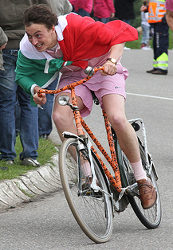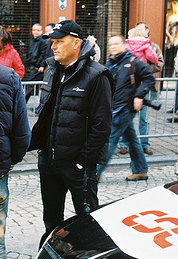 So for those of you scoring at home, that’s two consecutive Grand Tour starts in the Netherlands, and two consecutive Grand Tours marked by huge crowds, active racing, and scenes of epic carnage in the early going.
So for those of you scoring at home, that’s two consecutive Grand Tour starts in the Netherlands, and two consecutive Grand Tours marked by huge crowds, active racing, and scenes of epic carnage in the early going.
If the pattern continues, this year’s TdF depart in Rotterdam might just be that rapturous moment in which casual cycling fans finally dissociate “flat” from “boring” in their appreciation of the sport—unless, of course, Lance Armstrong crashes or misses a split. Then they’ll howl about how it’s not fair.
Regardless of the collective opinion of the sunburnt masses, I think a little chaos in the early going is a very good thing for Grand Tour racing, and for the sport in general. Too often—thanks especially to some over-zealous marketers of training plans and aero equipment—cycling competitions are cast as simple mathematical equations: watts/kg @ threshold, coefficient of drag x velocity^2, etc.
But off the trainer, in real-world wind tunnels, cycling’s as much about Spider Sense as anything else. Finding your way onto the right wheel; anticipating nervous moments and getting a good position before the battle starts; knowing which splits will take care of themselves and which you should bury yourself closing—these are the elements that get Grand Tour champions through the first week.
Some are tempted to credit these skills to the director and the radio; these people need to spend more time racing. The time scale of swerves and wheel touches is a fraction of the cognitive lag involved in any verbal communication, let alone one taking place over the radio. While directors can yell at their riders to move up, no amount of haranguing can impart the balance and know-how to make progress in a shoulder-to-shoulder peloton.
 Cadel Evans pretty much hit the nail on the head with yesterday’s post-race tweet, though he was significantly less philosophical to see the Jersey leave his shoulders in the same fashion. While it may send the vehement anti-dopers into an emo funk, it should come as a surprise to no one that a canny veteran like Vino’ would end up in pink after another chaotic day.
Cadel Evans pretty much hit the nail on the head with yesterday’s post-race tweet, though he was significantly less philosophical to see the Jersey leave his shoulders in the same fashion. While it may send the vehement anti-dopers into an emo funk, it should come as a surprise to no one that a canny veteran like Vino’ would end up in pink after another chaotic day.
Even if you hate the action and can’t stand the outcome, first-week chaos should at least be viewed as an investment in the quality of future stages. When the favorites are all clustered at the front of the GC, no one takes chances.
You think the podium places would have plodded up Ventoux if Contador had lost four minutes instead of 40 seconds in the early going at last Year’s TdF? For that matter, would Stefano Garzelli have put on such a show chasing KOM points at last year’s Giro if his squad hadn’t essentially lost the race for him in the opening day’s TTT?
Obviously, the current level of action isn’t sustainable, and probably not very fun for the riders—hopefully, the team time trial later this week take the nervousness out of pack. I think there’s a sweet spot for Grand Tours where the time gaps among the favorites are established enough that a touch of wheels won’t prove decisive, but where a big effort by a few teams could still alter the GC race.
With a little luck the TTT results will hit that sweet spot, and we’ll stay there until the final time trial in Verona.
Well said about the veteran’s abilities to read a race and stay out of trouble. Last I checked, there was no drugs used by cyclists for the purpose of sharpening their tactic and wit.
Never expect Cadel Evans to state the case with poetic elegance. When it does happen, I cherish it. When it doesn’t, it is just like 90% of his remarks to the press. Don’t fault him, BMC didn’t hire him to be a figurehead or public speaker.
Please tell me you didn’t use the phrase “epic carnage” for any reason other than irony?
If vino stays in pink till verona i think I will top myself. we don’t need unrepentant cheats like vino in our sport.
That crash in the Vuelta was in Belgium, close to Liege.
Vino is the current greatest character in our sport. what we need are more racers with his aggression and attention to fashion. he is a king.
Somehow the two biggest crashes of the second stage happened when they were on a straight and broad roads.
I just caught the “highlights” video from Universal Sports that was posted over on Steephill.tv. The American announcers are so terrible and out of touch with the actual race action that I’d rather watch a race with Flemish commentary (which I usually do).
“When the favorites are all clustered at the front of the GC, no one takes chances.”
Really? I love it when a grand tour hits the mountains with only prologue-sized differences between the favorites. Then the onus is on everyone to attack, because they’ve got a blank slate, and whatever gaps they get WILL be the GC that night. True, there’s a special incentive to attack when you’re four minutes down; but there’s also an incentive on the part of the other guy to simply shut your move down and then not counter with one of his own.
At any rate, I prefer the gaps created by this sort of chaos to the gaps created by TTTs. Those tend to reinforce differences in team-strength that are going to matter anyway, virtually guaranteeing that the two or three conventional favorites don’t have to worry about the wild-cards. This Giro might be an exception, of course, because the strongest TTT teams don’t have GC favorites, while the favorites’ teams (BMC, post-Bruyneel Astana) are unknown quantities.
…i just live near the boarder to the netherlands and saw the vuelta live last year and the giro at the TV. …the netherlands are really crazy about cycling!!
…gruß uli
@Sebastian: But when everyone’s close, there’s that incentive not to take that risk as well—the guy in second doesn’t want to make that attack, blow up, and then lose time.
Some of the best racing I’ve seen came at the end of the ’05 Giro, with Savodelli leading by two minutes over Simoni, and Rujano/DiLuca around a minute behind him. Without the minute to burn, I don’t think Simoni makes a move with Rujano, knowing he’ll probably lose time to the little guy at the finish.
@Juano: Do I detect a note of sarcasm?
@Tommeke: But the stage began in the Netherlands, so my hypothesis remains valid.
@Joe: I can’t imagine that Vino’ isn’t going to hemorrhage time in the mountains. Dude is looking beefy.
@Adam Myerson: I hang my clichéd head in shame.
Having the unpredictability of weather conditions, wind, equipment failure etc isn’t enough for you? There must be carnage to spur interest? Is the idea to have athletes break collarbones so as to rearrange things and create greater TV fan enthusiasm? Then why not allow them to dope or allow the crowd to pelt them with things gladiator style? Or – in order to limit the violence – why not have a lottery at the beginning of some stages where every rider gets a randomly assigned time penalty?
Come on now. If flat stages are that boring to the fans, then remove them, not turn them into obstacle courses and the race into a demolition derby.
It’s not the crashes, per se, but the chaos they create and the race situations that result. A good crosswind, bergs, cobbles, traffic furniture—all of these things bring the more nuanced aspects of cycling into play. The point isn’t to be a lottery, but to reward cyclists who are attentive, calm, and skillful when holding wheels gets tough.
In a way, these flat-stage challenges are like the big climbs—some riders are better than others. The ones that aren’t so great but ride within themselves can usually limit their losses and finish OK. Those that aren’t good, but still try to ride with the best suffer for it—just by crashing instead of blowing up and missing the time cut.
I don’t think flat stages should be removed because I don’t think flat stages are boring. There’s enough action in the final kilometers of a group sprint stage to keep me poring over footage for hours.
But I think an appreciation for what it takes to stay in the pack as the sprinters sort out who’ll have a shot at winning the stage is best cultivated by watching how riders stay out of trouble on stages like we saw earlier this week.